How to Grow Nectarines: Complete Guide for Sweet Success
- March 4, 2024
- 1 comment
The nectarine, with its smooth skin and sweet, juicy flesh, is a delightful summer fruit. A close relative of the peach, nectarines are not only delicious but also packed with nutrients. Growing your own nectarine tree can be a rewarding endeavor for any gardening enthusiast. This article will guide you through the steps to cultivate and care for nectarine trees, ensuring a bountiful harvest.
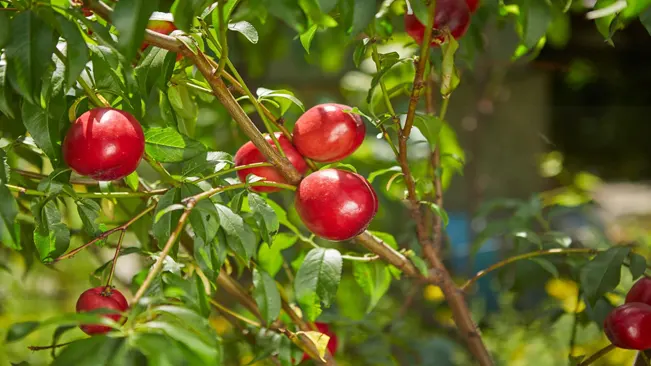
Nutritional Benefits of Nectarines
| Benefit | Description |
|---|---|
| Nutrient Rich | Nectarines are packed with essential vitamins and minerals, including Vitamin C, Vitamin A, potassium, and fiber. |
| Low in Calories | They are a low-calorie fruit, making them a healthy snack option for weight management. |
| Antioxidant Properties | Nectarines contain antioxidants like beta-carotene and flavonoids, which help fight free radicals and reduce oxidative stress. |
| Heart Health | The potassium content in nectarines can help regulate blood pressure levels, promoting heart health. |
| Improved Digestion | High in dietary fiber, nectarines aid in digestion and help prevent constipation. |
| Skin Health | Vitamin A and C in nectarines are beneficial for skin health, potentially improving skin texture and complexion. |
| Immune Support | The vitamin C in nectarines supports the immune system, helping the body resist infections and diseases. |
| Eye Health | Lutein and zeaxanthin, present in nectarines, are known to support eye health and may reduce the risk of age-related eye diseases. |
| Anti-Inflammatory | Compounds in nectarines have anti-inflammatory properties, which can help in reducing inflammation in the body. |
| Bone Health | Nectarines contain nutrients like phosphorus and calcium, which are essential for maintaining healthy bones. |
Choosing the Right Variety
Nectarines come in various types, each with its own climate preferences. When selecting a variety, consider your local weather conditions and the amount of space you have. There are dwarf varieties suitable for small gardens or even containers. Popular varieties include ‘Fantasia’, ‘Sunred’, and ‘Arctic Rose’.
Fantasia
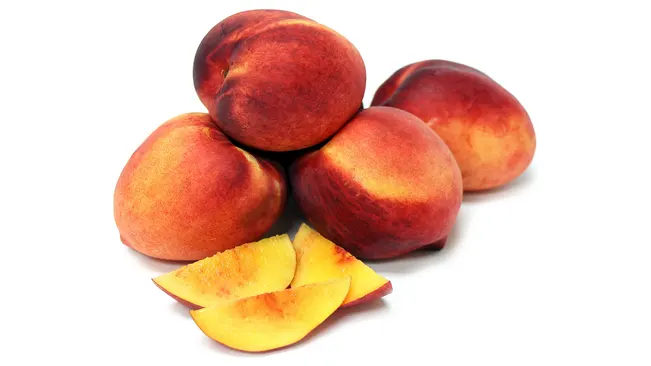
- Climate Suitability: ‘Fantasia’ is a high-chill variety, making it suitable for cooler climates.
- Fruit Characteristics: This variety produces large, yellow-fleshed fruit with a red blush. The nectarines are known for their sweet, intense flavor and firm texture.
- Maturity: It typically ripens in mid to late summer.
Sunred
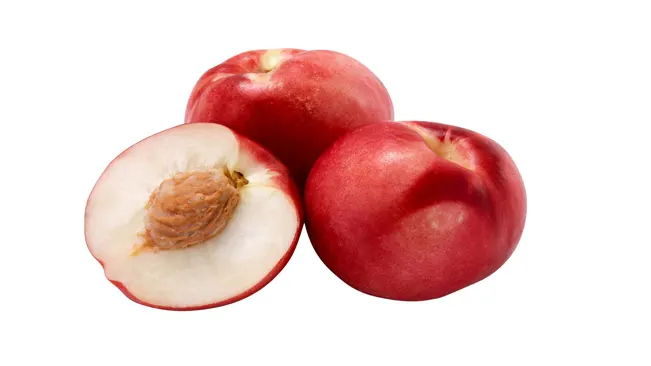
- Climate Suitability: ‘Sunred’ nectarines do well in a variety of climates, including moderate zones. They are moderately tolerant to lower chill hours.
- Fruit Characteristics: These nectarines have a striking red skin and a creamy, white flesh. They are cherished for their aromatic and sweet flavor.
- Maturity: This variety tends to ripen earlier in the season, often in late spring to early summer.
Arctic Rose
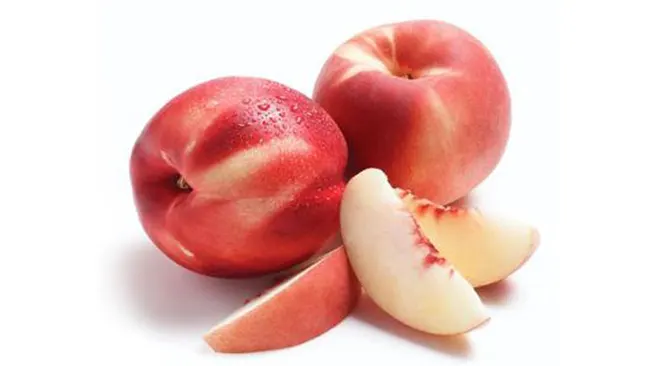
- Climate Suitability: Ideal for warmer climates, ‘Arctic Rose’ is a low-chill variety, requiring fewer cold hours.
- Fruit Characteristics: It is notable for its white flesh, which is incredibly sweet and juicy, with a smooth, red skin.
- Maturity: Harvest time for ‘Arctic Rose’ is usually in the mid-summer months.
Considering Space and Growth Habits:
When selecting a nectarine variety, also consider the space available in your garden. Dwarf and semi-dwarf varieties are excellent for smaller spaces or container gardening. These types usually grow to about half the size of standard trees, making them easier to manage, especially for pruning and harvesting.
- Dwarf Varieties: These are ideal for container gardening or small garden spaces. They can be as short as 5-6 feet tall but still produce a generous amount of fruit.
- Semi-Dwarf Varieties: These grow a bit larger than dwarf trees but are still suitable for limited spaces. They typically reach heights of about 12-15 feet.
Planting Your Tree
The best time to plant nectarine trees is in the late winter or early spring. Choose a sunny spot with well-draining soil. Nectarines need full sunlight for at least six hours a day. Planting the tree in a hole twice as wide but just as deep as the root ball is crucial. This gives the roots plenty of room to expand.
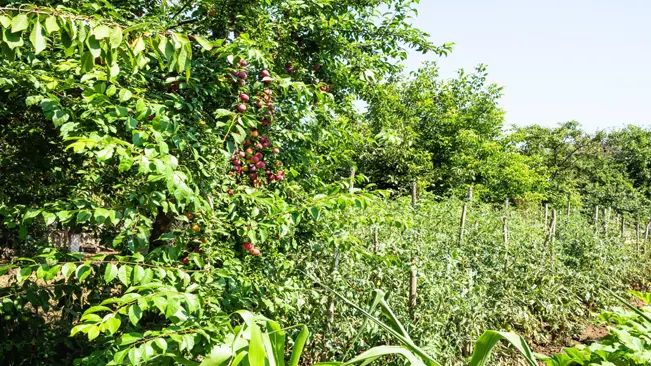
- Timing is Key: Planting in late winter or early spring is ideal because this period precedes the growth spurt of spring. This timing allows the tree to establish its roots in the soil before the energy is directed towards leaf and fruit production.
- Location Selection: Nectarines require a location that receives full sunlight for at least six hours per day. Sunlight is essential for the health of the tree and the development of the fruit. Additionally, ensure that the site is protected from strong winds, which can damage the tree and its fruit.
- Soil Preparation: Nectarine trees prefer well-draining soil. If your soil is heavy or clay-like, consider amending it with organic matter such as compost or aged manure to improve drainage. The ideal soil pH for nectarines is slightly acidic to neutral (pH 6.0 to 7.0). Conducting a soil test can be beneficial to determine the soil’s pH and nutrient levels.
- Digging the Hole: The hole should be dug twice as wide as the root ball of your nectarine tree but only as deep. This extra width ensures that the soil around the roots is loose, allowing for easier root expansion and better water absorption.
- Handling the Root Ball: Before placing the tree in the hole, gently spread out the roots if they are bunched up. If the tree is pot-bound (roots tightly wound around the container), gently tease the roots apart to encourage them to grow outward.
- Planting Depth: Place the tree in the hole so that the top of the root ball is level with the ground surface. Planting the tree too deep can lead to root rot and other issues.
- Backfilling the Hole: Fill the hole with the original soil mixed with some compost. Avoid using too much fertilizer at this stage, as it can burn the roots. Tamp down the soil gently to remove air pockets.
- Watering: After planting, water the tree thoroughly to settle the soil around the roots. This also helps eliminate air pockets. In the weeks following planting, keep the soil moist but not waterlogged. Overwatering can be just as harmful as underwatering.
- Mulching: Apply a layer of organic mulch around the base of the tree. This helps retain soil moisture, regulate soil temperature, and reduce weed competition. Keep the mulch a few inches away from the trunk to prevent rot.
- Staking: If the tree is tall or in a windy location, staking may be necessary for the first year. This provides support and helps the tree grow straight.
Soil and Fertilization
Nectarine trees thrive in slightly acidic to neutral soil (pH 6.0 to 7.0). It’s advisable to have your soil tested and amended as necessary. A balanced, all-purpose fertilizer applied in the spring can promote healthy growth. Avoid over-fertilizing, as this can lead to excessive leaf growth at the expense of fruit production.
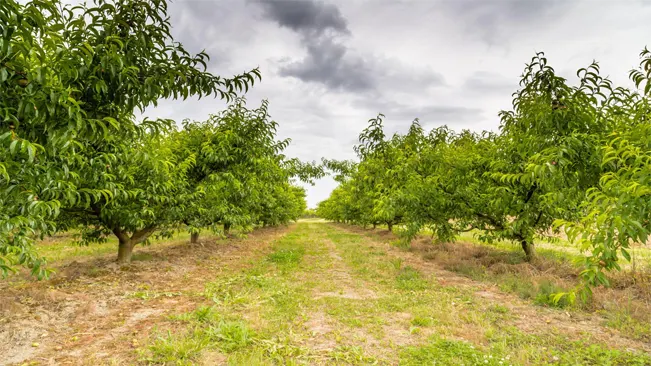
- Understanding Soil pH: The pH level of the soil is a critical factor in the health and productivity of nectarine trees. They prefer a slightly acidic to neutral pH, typically between 6.0 and 7.0. This pH range ensures that essential nutrients are readily available to the tree. If the soil is too acidic or too alkaline, it can hinder the tree’s ability to absorb nutrients, even if those nutrients are present in the soil.
- Testing and Amending Soil: Before planting a nectarine tree, it’s wise to test the soil’s pH. You can use a home testing kit or seek assistance from a local extension office. If the soil is not within the ideal pH range, it can be amended. To raise the pH (in overly acidic soil), you can add lime. To lower the pH (in overly alkaline soil), adding sulfur or organic matter like peat moss can be effective.
- The Importance of Well-Draining Soil: Nectarine trees do not fare well in waterlogged conditions. Therefore, well-draining soil is a must. If your soil is heavy in clay or retains water, consider planting the tree in a raised bed or amending the soil with organic matter to improve drainage.
- Fertilization Needs: Nectarine trees benefit from regular fertilization, especially in their growing stages. A balanced, all-purpose fertilizer, typically one with equal parts nitrogen, phosphorus, and potassium, is ideal. It’s recommended to fertilize in early spring as the tree exits dormancy and starts new growth.
- Avoiding Over-Fertilization: While fertilization is important, overdoing it can be detrimental. Excessive nitrogen, for instance, can lead to lush leaf growth at the expense of fruit production. It can also make the tree more susceptible to pests and diseases. Apply fertilizer according to the product instructions and the size and age of your tree.
Watering
Regular watering is essential, especially during the first few years of growth. The soil should be kept consistently moist but not waterlogged. Once established, nectarine trees are somewhat drought tolerant but will need more water during fruit development stages.
- Initial Watering After Planting: Immediately after planting your nectarine tree, it is essential to give it a thorough watering. This initial soaking helps settle the soil around the roots and eliminates air pockets, ensuring good contact between the roots and the soil. This step is crucial for the early establishment of the tree.
- Frequency of Watering: In the first growing season, nectarine trees require more frequent watering to support their developing root systems. Typically, watering once a week is sufficient, but this can vary depending on your local climate and soil type. In hotter, dryer climates, or if you have sandy soil, you may need to water more frequently.
- Deep Watering Technique: Deep watering is recommended for nectarine trees. This method involves watering slowly, allowing the moisture to penetrate deeply into the soil. Deep watering encourages the roots to grow downward, creating a more drought-resistant tree. You can achieve this by using a soaker hose or drip irrigation system, which delivers water directly to the base of the tree at a slow rate.
- Checking Soil Moisture: To determine when to water, check the soil moisture. The top 2-3 inches of soil should be dry before you water again. You can use a soil moisture meter or simply insert a finger into the soil to feel for moisture. Over-watering can be as harmful as under-watering, leading to root rot and other issues.
- Mulching: Applying a layer of organic mulch around the base of the nectarine tree can help retain soil moisture, reduce water evaporation, and keep the roots cool. Ensure the mulch is not touching the trunk of the tree to prevent rot and pest issues.
- Watering Mature Trees: Once established, nectarine trees become more drought-tolerant. However, they still require regular watering, especially during the fruit development stage. During this period, inadequate water can lead to smaller fruits or even fruit drop. It’s important to maintain a consistent watering schedule during dry spells.
- Seasonal Considerations: The watering needs of nectarine trees vary with the seasons. In spring and summer, when the tree is actively growing and fruiting, it requires more water. In contrast, during fall and winter, you should reduce watering as the tree goes into dormancy.
- Drought Conditions: In periods of drought, prioritize deep, infrequent watering to help the tree survive. While nectarine trees can withstand some drought, prolonged water stress can affect fruit production and overall tree health.
Pruning and Thinning
Pruning is vital for maintaining tree health and encouraging fruit production. Prune in late winter to remove dead or diseased branches and to shape the tree. Thinning the fruit is also crucial; it ensures larger and better-quality nectarines by preventing overburdening of the branches.
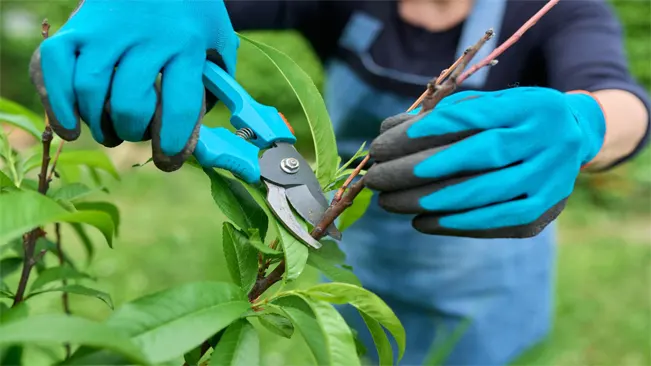
Pruning
Pruning a nectarine tree is both an art and a science, requiring a blend of technique and understanding of the tree’s growth patterns.
- Timing: The ideal time for pruning is late winter or very early spring, before the tree breaks dormancy and new growth begins. This timing helps prevent the spread of diseases and allows for better visibility of the tree’s structure.
- Objectives: The main goals of pruning are to remove any dead or diseased wood, to improve the tree’s structure and strength, and to allow light and air to penetrate the canopy, which is essential for fruit quality and disease prevention.
- Technique: Start by removing any branches that are damaged, diseased, or crossing and rubbing against each other. Then, focus on shaping the tree. For nectarine trees, an open center or vase shape is often recommended. This involves removing the central leader (the main upward branch) to create an open, bowl-shaped canopy.
- Regulating Growth: By pruning, you also regulate the tree’s growth and vigor. Too little pruning can lead to excessive vegetative growth and poor fruiting, while over-pruning can stress the tree and reduce its fruit yield.
Thinning
Thinning the fruit is as crucial as pruning and greatly impacts the quality and size of the nectarines.
- Timing of Thinning: Begin thinning when the fruits are about the size of a marble. This usually occurs several weeks after the tree has bloomed.
- Method: Gently remove excess fruits by hand, leaving about 2 to 4 inches of space between each remaining fruit. The exact spacing depends on the variety of nectarine and the overall fruit load on the tree.
- Benefits: Thinning reduces the competition among fruits for nutrients and sunlight. It leads to larger, healthier fruits and helps prevent limb damage from overbearing weight. It also can improve air circulation around the fruits, reducing the risk of fungal diseases.
- Impact on Future Harvests: Regular thinning also benefits future harvests. Trees that are consistently thinned tend to have more consistent and reliable yields year after year.
- Considerations: It might feel counterintuitive to remove fruit, but it’s a critical step. It’s important to balance the immediate desire for more fruit with the long-term health and productivity of the tree.
Pest and Disease Management
Nectarine trees can be susceptible to pests and diseases like peach leaf curl, aphids, and brown rot. Regular inspection and appropriate organic or chemical treatments can help manage these issues. Implementing a good hygiene practice by removing fallen leaves and fruits from around the tree can also reduce disease risks.
Peach Leaf Curl
Peach leaf curl is a common fungal disease that also affects nectarines. It causes leaves to become distorted and reddened. The disease thrives in cool and wet spring weather. To prevent peach leaf curl:
- Apply a fungicide spray in late autumn or early spring before the buds open.
- Choose resistant varieties if they are available in your region.
- Remove and destroy any infected leaves to prevent the spread.
Aphids
Aphids are small, sap-sucking insects that can weaken the tree and reduce fruit quality. They also excrete a sticky substance called honeydew, which can lead to sooty mold. Managing aphids involves:
- Introducing natural predators like ladybugs or lacewings into your garden.
- Using insecticidal soaps or oils which are less harmful to beneficial insects.
- Spraying a strong jet of water to physically remove aphids from the leaves.
Brown Rot
Brown rot is a fungal disease that causes fruit to rot and become mummified on the branch. It is a significant issue, especially in humid climates. To combat brown rot:
- Practice good sanitation by removing any affected fruits and clearing debris from under the tree.
- Ensure good air circulation around the tree by proper pruning.
- Apply a suitable fungicide, especially during the flowering period and just before the fruit ripens.
Regular Inspection and Hygiene
Regularly inspecting your tree for signs of pests and disease is crucial. Early detection can make management much more manageable. Additionally:
- Maintain good hygiene around the tree. Remove fallen leaves and fruits which can harbor pests and diseases.
- Mulch around the base of the tree to prevent spores from splashing up from the soil.
Integrated Pest Management (IPM)
- Consider adopting an Integrated Pest Management approach. IPM involves using the least toxic methods first, like manual removal of pests or using barriers, and gradually moving to chemical controls if necessary. This approach is environmentally friendly and helps preserve beneficial organisms in your garden.
Harvesting
Nectarines are usually ready for harvest in late summer. The fruit should come off the tree easily with a gentle twist. The color, aroma, and slight softness at the stem end are good indicators of ripeness. Harvesting at the right time ensures the best flavor.
Timing is Key
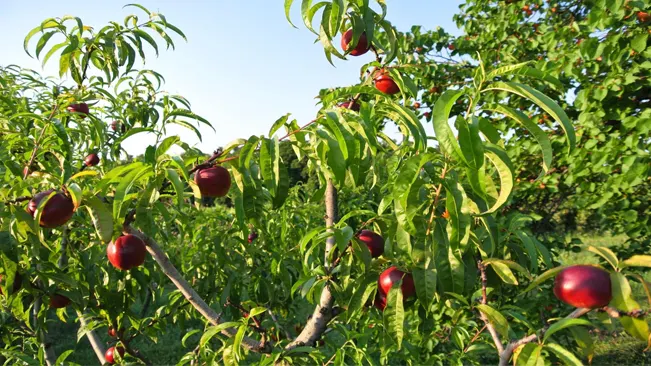
- Seasonal Harvest: Nectarines typically ripen in late summer, although the exact timing can vary depending on the climate and variety. It’s crucial to observe the fruit’s development closely as the harvest season approaches.
- Ripeness Indicators: Nectarines won’t continue to ripen significantly once picked, so harvesting them at the right stage of ripeness is essential. The fruit should feel firm but slightly soft to the touch, especially near the stem end. Overripe nectarines may become mushy, while underripe ones will lack sweetness and flavor.
Visual and Aromatic Cues

- Color: Look for a vibrant, consistent coloration. The background color of the nectarine should have changed from green to yellow or orange, depending on the variety. This is a more reliable indicator than the red blush, which can develop even on fruits that aren’t fully ripe.
- Aroma: Ripe nectarines emit a sweet and fragrant aroma. If the fruit smells fragrant and sweet at the stem end, it’s likely ready to be picked.
The Harvesting Process
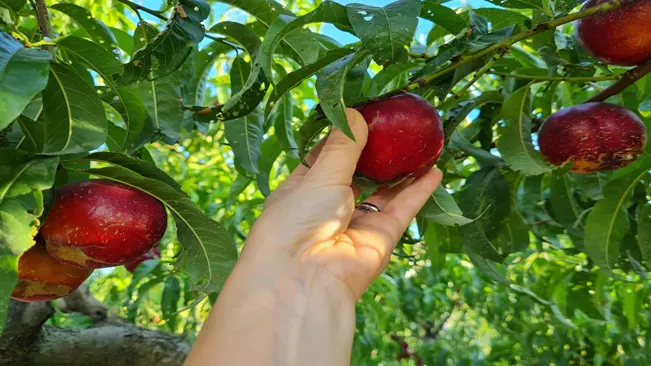
- Gentle Handling: Use a gentle hand when picking nectarines. They should come away from the tree with a slight twist. If you have to pull hard, the fruit may not be ripe enough.
- Daily Checks: As the harvest season peaks, check your tree every day or two. Nectarines can ripen quickly, and missing the optimal picking time can lead to a loss in quality.
- Storage and Usage: Once picked, nectarines can be eaten immediately, stored at room temperature for a few days to soften further, or refrigerated to extend their shelf life for about a week. They can also be canned, frozen, or dried for long-term storage.
FAQs (Frequently Asked Questions)
- What climate is best for growing nectarines?
- Nectarines thrive in warm, temperate climates. They need a chilling period (cold temperatures) in winter to break dormancy, but can be sensitive to late spring frosts.
- Nectarines thrive in warm, temperate climates. They need a chilling period (cold temperatures) in winter to break dormancy, but can be sensitive to late spring frosts.
- How much sun do nectarine trees need?
- Nectarine trees require full sun, meaning at least 6-8 hours of direct sunlight per day.
- Nectarine trees require full sun, meaning at least 6-8 hours of direct sunlight per day.
- What type of soil is ideal for nectarine trees?
- Well-draining, loamy soil with a pH between 6.0 and 7.0 is ideal. Soil should be moderately fertile.
- Well-draining, loamy soil with a pH between 6.0 and 7.0 is ideal. Soil should be moderately fertile.
- How do I water my nectarine tree?
- Water deeply once a week, ensuring the soil is moist but not waterlogged. Adjust frequency based on weather conditions and soil type.
- Water deeply once a week, ensuring the soil is moist but not waterlogged. Adjust frequency based on weather conditions and soil type.
- When is the best time to plant nectarine trees?
- Early spring is the best time to plant nectarine trees, after the last frost date in your area.
- Early spring is the best time to plant nectarine trees, after the last frost date in your area.
- How far apart should I plant nectarine trees?
- Plant nectarine trees about 15-20 feet apart to allow enough space for growth and air circulation.
- Plant nectarine trees about 15-20 feet apart to allow enough space for growth and air circulation.
- Do nectarine trees need to be pruned?
- Yes, annual pruning during the dormant season (late winter or early spring) is necessary for shaping the tree, removing dead or diseased wood, and encouraging fruit production.
- Yes, annual pruning during the dormant season (late winter or early spring) is necessary for shaping the tree, removing dead or diseased wood, and encouraging fruit production.
- How long does it take for a nectarine tree to bear fruit?
- Most nectarine trees begin to bear fruit 2-4 years after planting, depending on the variety and growing conditions.
- Most nectarine trees begin to bear fruit 2-4 years after planting, depending on the variety and growing conditions.
- Do I need more than one nectarine tree for pollination?
- Most nectarine varieties are self-fertile, so you don’t necessarily need more than one tree for pollination. However, having additional trees can improve yield.
- Most nectarine varieties are self-fertile, so you don’t necessarily need more than one tree for pollination. However, having additional trees can improve yield.
- How do I protect my nectarine tree from pests and diseases?
- Regularly inspect for signs of pests and diseases. Use appropriate fungicides or insecticides, following the manufacturer’s instructions. Implementing good cultural practices, like proper watering and pruning, also helps prevent many problems.

Kristine Moore
Forestry AuthorI'm Kristine Moore, a seasoned garden landscaping professional with over 30 years of experience. My extensive career has been dedicated to transforming outdoor spaces into stunning, sustainable landscapes. With a deep understanding of horticulture, design principles, and environmental stewardship, I have become a respected figure in the field, known for creating harmonious, visually appealing, and eco-friendly gardens. My commitment to excellence and continuous learning in landscaping trends and techniques has solidified my reputation as an expert in garden design and implementation.













I have a nectarine tree which is at least 5 years old. The leaves on it are less than an inch long. It flowered, but does not have fruit forming. What could be wrong with it?
Sharon
May 20, 2024 10:51 pm